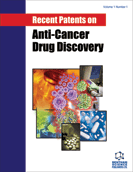Abstract
Alteronol, isolated from microbial mutation strains, has been applied for Chinese and International patents for tumor treatment. The aim of this project study is to investigate characteristics of proliferation and redifferentiation induced by alteronol in B16-F0 mouse melanoma cells. Cell proliferation is determined by tetrazolium salt colorimetric method (MTT assay). Morphological changes were analyzed by using Giemsa staining. The levels of melanin and tyrosinase were measured by spectrophotometry. The mRNA expressions of tyrosinase-related protein Trp1 and Trp2 were evaluated by reverse transcription-polymerase chain reaction (RT-PCR). The anchorage-independent proliferation of B16-F0 was monitored by the colony formation assay. Tumorigenicity was characterized by an animal model in vivo. The results showed that the proliferation of B16-F0 cells was inhibited by alteronol in a concentration and time dependent manner. All well-known evaluation indexes of melanoma cell differentiation, including morphological changes and tyrosinase activity alteration, were greatly enhanced with the increase of alteronol concentrations. Taken together, the expression of tyrosinase related gene, decreased cell colony formation rate and the tumorigenicity in vivo; all of these revealed that alteronol plays a key role in inducing differentiation and suppressing the proliferation of B16-F0 tumor cells in vitro and in vivo.
Keywords: Alteronol, B16F0, differentiation, melanin, tyrosinase, tumorigenicity.
Recent Patents on Anti-Cancer Drug Discovery
Title:Alteronol Induces Differentiation of Melanoma B16-F0 Cells
Volume: 10 Issue: 1
Author(s): Caixia Wang, Bo Zhang, Na Chen, Liangliang Liu, Jinglei Liu, Qi Wang, Zhenhua Wang, Xiling Sun and Qiusheng Zheng
Affiliation:
Keywords: Alteronol, B16F0, differentiation, melanin, tyrosinase, tumorigenicity.
Abstract: Alteronol, isolated from microbial mutation strains, has been applied for Chinese and International patents for tumor treatment. The aim of this project study is to investigate characteristics of proliferation and redifferentiation induced by alteronol in B16-F0 mouse melanoma cells. Cell proliferation is determined by tetrazolium salt colorimetric method (MTT assay). Morphological changes were analyzed by using Giemsa staining. The levels of melanin and tyrosinase were measured by spectrophotometry. The mRNA expressions of tyrosinase-related protein Trp1 and Trp2 were evaluated by reverse transcription-polymerase chain reaction (RT-PCR). The anchorage-independent proliferation of B16-F0 was monitored by the colony formation assay. Tumorigenicity was characterized by an animal model in vivo. The results showed that the proliferation of B16-F0 cells was inhibited by alteronol in a concentration and time dependent manner. All well-known evaluation indexes of melanoma cell differentiation, including morphological changes and tyrosinase activity alteration, were greatly enhanced with the increase of alteronol concentrations. Taken together, the expression of tyrosinase related gene, decreased cell colony formation rate and the tumorigenicity in vivo; all of these revealed that alteronol plays a key role in inducing differentiation and suppressing the proliferation of B16-F0 tumor cells in vitro and in vivo.
Export Options
About this article
Cite this article as:
Wang Caixia, Zhang Bo, Chen Na, Liu Liangliang, Liu Jinglei, Wang Qi, Wang Zhenhua, Sun Xiling and Zheng Qiusheng, Alteronol Induces Differentiation of Melanoma B16-F0 Cells, Recent Patents on Anti-Cancer Drug Discovery 2015; 10 (1) . https://dx.doi.org/10.2174/1574892809666140923125521
| DOI https://dx.doi.org/10.2174/1574892809666140923125521 |
Print ISSN 1574-8928 |
| Publisher Name Bentham Science Publisher |
Online ISSN 2212-3970 |
Related Books
 63
63 1
1 1
1
- Author Guidelines
- Bentham Author Support Services (BASS)
- Graphical Abstracts
- Fabricating and Stating False Information
- Research Misconduct
- Post Publication Discussions and Corrections
- Publishing Ethics and Rectitude
- Increase Visibility of Your Article
- Archiving Policies
- Peer Review Workflow
- Order Your Article Before Print
- Promote Your Article
- Manuscript Transfer Facility
- Editorial Policies
- Allegations from Whistleblowers
Related Articles
-
γ δ T Cell Modulation in Anticancer Treatment
Current Cancer Drug Targets Mistletoe and Garlic Extracts as Polyurethane Carriers – A Possible Remedy for Choroidal Melanoma
Current Drug Delivery The Possible Involvement of Glycogen Synthase Kinase-3 (GSK-3) in Diabetes, Cancer and Central Nervous System Diseases
Current Pharmaceutical Design Exosome Limitations in the Treatment of Inflammatory Diseases
Current Pharmaceutical Design Beyond the Selective Inhibition of Histone Deacetylase 6
Mini-Reviews in Medicinal Chemistry Antagonists of Growth Hormone-Releasing Hormone in Oncology
Combinatorial Chemistry & High Throughput Screening Looking Beyond Inhibition of VEGF/mTOR: Emerging Targets for Renal Cell Carcinoma Drug Development
Current Clinical Pharmacology OX40 and OX40L Interaction in Cancer
Current Medicinal Chemistry Design of Peptide Imaging Agents for Whole-body and Intraoperative Molecular Imaging
Current Medicinal Chemistry Structural and Bioactive Properties of 3-O-Methylfunicone
Mini-Reviews in Medicinal Chemistry Chemoprevention Gene Therapy (CGT) of Pancreatic Cancer Using Perillyl Alcohol and a Novel Chimeric Serotype Cancer Terminator Virus
Current Molecular Medicine Inhibitors of Cyclin Dependent Kinases: Useful Targets for Cancer Treatment
Current Cancer Drug Targets Nanomedicine to Deal With Cancer Cell Biology in Multi-Drug Resistance
Mini-Reviews in Medicinal Chemistry Extracellular Vesicles as Innovative Tools for Assessing Adverse Effects of Immunosuppressant Drugs
Current Medicinal Chemistry Polysaccharide Colloids as Smart Vehicles in Cancer Therapy
Current Pharmaceutical Design Omega-3 Polyunsaturated Fatty Acids and Cancer
Anti-Cancer Agents in Medicinal Chemistry Cellular Uptake of Cell-Penetrating Peptides
Drug Design Reviews - Online (Discontinued) In Vitro Antitumoral Activity of Palladium(II) and Platinum(II) Complexes with O,O'-Dialkyl Esters of Ethylene-bis(S)-Leucine
Letters in Drug Design & Discovery More Good News About Polymeric Plant- and Algae-Derived Biomaterials in Drug Delivery Systems
Current Drug Targets Proceedings of the 1<sup>st</sup> Puerto Rico Biobanking Workshop
Reviews on Recent Clinical Trials


























